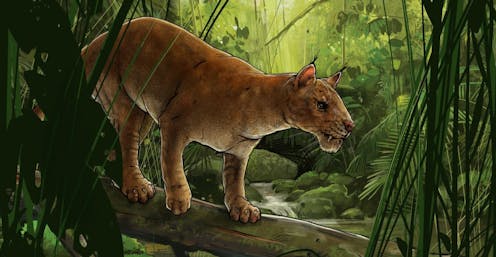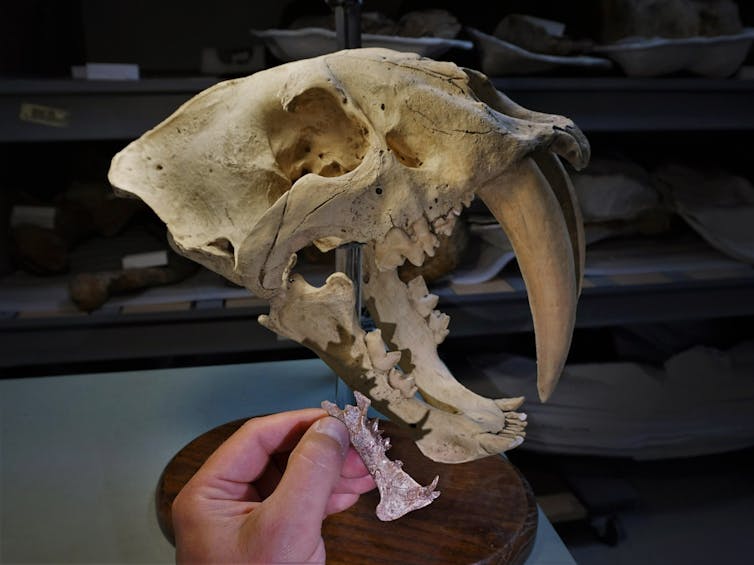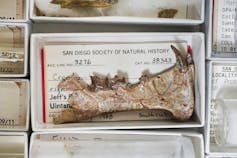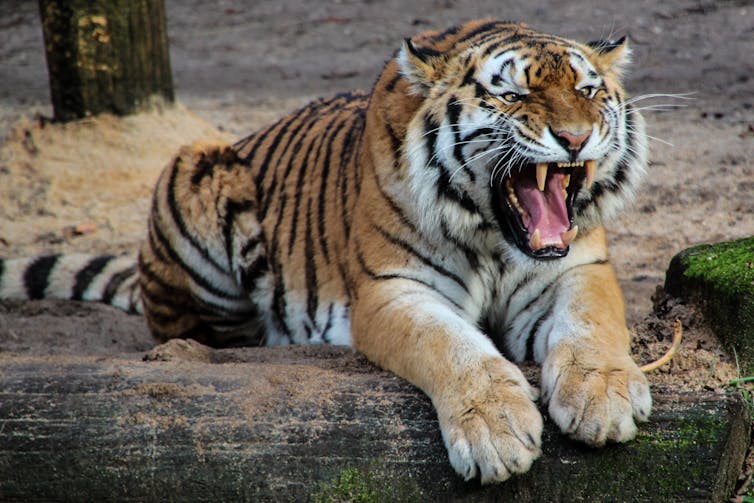
Although they are currently the greatest predators on land, it’s likely that modern-day cats wouldn’t have been a match for the newly discovered Diegoaelurus vanvalkenburghae. At around 42 million years old, it’s thought to be one of the first sabre-tooth cat-like predators to have roamed the planet – and a formidable hunter capable of killing prey much larger than itself.
None of our existing top predators possess a sabre-tooth. But throughout much of the history of wild cats, there have been sabre-toothed forms.
Indeed, from 2.5 million years ago, until as recently as 10,000 years ago, the iconic Smilodon fatalis – commonly known as the sabre-tooth tiger – was on the prowl in California and other parts of North and South America. Although its main focus were the large, thick-skinned mammoths and woolly rhinos, early humans might well have been at risk, too.
Though this newly described animal was smaller than Smilodon, the sabre-tooth adaptation means it was probably one of the first ever mammalian hypercarnivores, surviving almost exclusively on a diet of meat – a lifestyle followed by modern cats today.
The sabre-tooth discovery
In the new PeerJ study scientists from the University of Arizona and San Diego Natural History Museum describe the new predator, which they named Diegoaelurus vanvalkenburghae after San Diego county, in southern California, where the fossil was found, and Professor Van Valkenburgh, the doyenne of carnivore evolution.
The beautiful piece of lower jaw had sat unappreciated in the drawers of the San Diego museum since 1988 – until Curator Ashley Poust found it and recognised what it was. And although it doesn’t sound like much to go on, we can actually learn a huge amount about this ancient creature from the fossilised jaw and teeth alone.

At the back of the newly discovered jaw there are slicing scissor teeth, called carnassials – the equivalent of molars and premolars – shaped like flesh-cutting blades with multiple points. Going forward in the jaw, there is a long gap, and then the key tooth, the canine sabre-tooth, elongated and curved. Below that, is an expanded and deepened portion at the front of the jawbone that partly accommodates the deeply rooted canine tooth, and also provides added strength for the jawbone when it bites with force.
The unpreserved upper jawbone would have featured an equivalent canine sabre tooth, which would have cut down outside the jaw as the animal seized its prey.

The fossil also allowed the study authors to identify that Diegoaelurus is a machaeroidine, a sub-family of extinct mammals from North America and Asia. But our new knowledge doesn’t end there. From long-term studies of the rocks and fossils of California, scientists can form a picture of the newly discovered animal’s habitat and lifestyle.
California in the middle Eocene – the time 42 million years ago when Diegoaelurus lived – was a land of rich tropical forests through which the bobcat-sized Diegoaelurus slipped silently in search of prey. The forests teemed with rodents and early primates in the trees, as well as larger herbivorous mammals, such as even-toed oreodonts (most closely related to camels and pigs), early hoofed tapiroids, multi-toed horses, and the small rhinocerous Menoceras, on the ground.
Perhaps this first sabre-tooth concentrated on hunting these thick-skinned ungulates, leaping from the trees onto their backs and biting suddenly and deeply.
Could the sabre-tooth return?
Although Diegoaelurus looked similar to cats, they are, in fact, unrelated. But the sabre-toothed adaptation to hypercarnivory arose independently several times among cats in other extinct sub-families, such as the nimravids, the “sabre-tooth false cats” in North America and Eurasia – and even in the marsupial thylacosmilids of South America.
Read more: When two ecosystems collided, ichthyosaurs re-evolved the ability to consume large prey
But when Smilodon – the last known survivor of the most recent sub-family, Machairodontinae – became extinct, probably due to loss of prey or hunting by early humans, the sabre-tooth disappeared.

Most cats today operate as solitary hunters, and so generally tackle prey that is of a similar size to themselves, or smaller, in contrast to the sabre-tooths who were able to take on much larger prey.
The modern family Felidae – which includes all modern cats – has 41 species, including the pantherines, such as lions, tigers and leopards, and the felines, such as cheetahs, pumas and caracal. Some of the larger cats – tigers and lions, for example – are hypercarnivores who live only on the flesh of other large animals. Smaller cats are carnivores, of course, but with broader diets which can include rodents, birds, lizards and even invertebrates such as bugs and beetles.
It could be suggested that sabre teeth are an adaptation that is urgently required by many modern large cats. Lions and tigers do have large canine teeth that are used to pierce and kill – but they could certainly benefit from canines that are longer and stronger.
When a lion tries to bring down a Cape buffalo or a juvenile elephant, it struggles to make a killing bite. Even Chilean pumas struggle to bite through the hide of a guanaco (a native of South America and close relative of the llama) and only succeed in killing their prey in one hunt out of ten. And with their thicker skin, pachyderms like buffalo, hippos, rhinos and elephants are more or less immune from attack.
Indeed, sabre-teeth could save the lives of many modern large hunting cats by making the hunt safer. So will one of the modern cat species evolve them? Well, it seems like leopards might already be moving in that direction, so only time will tell.
Michael J. Benton does not work for, consult, own shares in or receive funding from any company or organisation that would benefit from this article, and has disclosed no relevant affiliations beyond their academic appointment.
This article was originally published on The Conversation. Read the original article.







